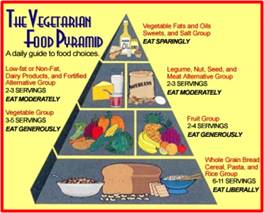Monday Author: Susanne Skinner
 A vegetarian is someone who doesn’t eat meat, including beef, chicken, pork, or fish and may or may not choose to eat other animal products such as eggs, dairy or honey.
A vegetarian is someone who doesn’t eat meat, including beef, chicken, pork, or fish and may or may not choose to eat other animal products such as eggs, dairy or honey.
Some people (like me) follow a semi-vegetarian diet also called a flexitarian diet, which is primarily plant-based but includes smaller quantities of protein like meat, dairy, eggs, poultry and fish. I’ve never considered becoming a full vegetarian for one basic reason: I like steak.
Not just any steak, because mediocre steak is easy to leave behind. The gold standard for me is my brother-in-law Tom’s hand-cut and seasoned rib eye steak cooked to perfection on the grill. Nothing else comes close. Since we don’t live near each other I rarely enjoy this pleasure.
The Way Things Used To Be
Eating Vegetarian is not a new concept. The term was coined by the British Vegetarian Society in the 1800s but vegetarianism existed before recorded history.
 Most early humans ate plants because they were gatherers not hunters. Meat had to be caught and was often scarce due to climate and primitive weapons. People ate what was available, usually plants.
Most early humans ate plants because they were gatherers not hunters. Meat had to be caught and was often scarce due to climate and primitive weapons. People ate what was available, usually plants.
Vegetarianism in the United States became popular in the 1970s when Frances Moore Lappé, a UC Berkeley student researching world hunger, published Diet for a Small Planet Her book became a best seller that introduced Americans to a new way of eating. She wrote about healthy ways to be vegetarian and included recipes without meat that actually tasted good. People, especially hippies and communes that grew their own vegetables, were quick to jump on the bandwagon. A new genre of eating and cooking was born.
But mainstream vegetarianism still had challenges. Even though the movement started in the 70s it had many misconceptions and myths. Those contemplating becoming vegetarian were reluctant because of the planning and preparation they thought was required and many questioned the health benefits of a diet without meat.
One of the biggest misconceptions was the food itself. Vegetarian cooking had a bad rap. This was the canned vegetable generation. “Fresh” was a relative term and did not define family meals. Vegetarians were offered a choice of soy protein (the 80s Boca Burger) or pasta. If you were gluten free…well, good luck to you.
The Modern Vegetarian
Today farm-to-table cooking is the new normal, organic and non GMO produce is readily available, along with Community Supported Agriculture (CSA) boxes in many towns. Many people have vegetable and herb gardens and labeling of foods has come a long way.
Vegetarian cookbooks also helped change people’s perceptions. Two of the most well-known are Anna Thomas’ The Vegetarian Epicure and Molly Katzen’s Moosewood Cookbook; long standing favorites in my repertoire. The Vegetarian Times published a companion cookbook to their magazine that I still use. These books showcase every fruit, vegetable, bean, and whole grain with endless ways to flavor and prepare them. A quick Google search points to many more.
 Today people become vegetarian for a variety of reasons. Common motivators include the environment, animal rights, and, of course, health. A key reason is to reduce the risk of heart disease, diabetes and some cancers or to simply adopt a healthier life style that eliminates meat.
Today people become vegetarian for a variety of reasons. Common motivators include the environment, animal rights, and, of course, health. A key reason is to reduce the risk of heart disease, diabetes and some cancers or to simply adopt a healthier life style that eliminates meat.
In the early 90s, the American Dietetic Association published a position paper endorsing vegetarian diets, and they also gained support within the medical community. The U.S. government dropped the outdated meat & dairy industry-sponsored Four Food Groups and replaced it with a Food Pyramid, clearly showing the importance of grains, vegetables, beans, and fruits.
Today, acceptance of vegetarianism by medical authorities and the general public is at an all-time high. There are newer cookbooks available that speak to healthy flavorful meals. My new favorite is Israeli born chef and restaurateur Yotam Ottolenghi.
Though not a vegetarian himself, his style is rooted in middle-eastern flavors and his recipes are not overly complex; his hummus is the best I’ve ever had. If you’re feeling adventurous, try his chickpeas and spinach with honeyed sweet potato.
Fighting Disease with Diet
I wanted a real example of someone’s life profoundly changed by diet, so I reached out to my friend Doug. Eight years ago Doug suffered a blockage in the lower arterial descending artery, a heart attack also known as the widow maker. It has a 10% survival rate.
 Doug was one of the 10%. He received a stent and was told he would be on heart medication the rest of his life. He left the hospital with minimal post-surgical guidance and was told to return for a yearly stress test and to eat lean meats.
Doug was one of the 10%. He received a stent and was told he would be on heart medication the rest of his life. He left the hospital with minimal post-surgical guidance and was told to return for a yearly stress test and to eat lean meats.
Doug researched and found Dr. Caldwell Esselstyn’s book Prevent and Reverse Heart Disease but felt it was too extreme to give up the foods he enjoyed. One year later he was having another angiogram that confirmed a 60% blockage. You must have at least 70% to warrant a stent so he was told to go home and “see how it goes.” Doug was not willing to take any further risks and decided commit to diet as the way to address his heart disease.
He and his wife adopted a Whole Food Plant Based diet with no oil (WFPBNO). Today Doug is off all medications, even a daily aspirin, 55 pounds lighter and loving life. He is also an amazing cook. Be inspired.
Healthy Eating
Our nation has become focused on healthy eating. This generation demands to know what is in the food they eat. Steaming has replaced frying; freshness and seasonality are new metrics for how we cook and eat.
The word vegetarian has become more than a diet term—it has become a way of sustainable living—and when you don’t have meat in your freezer you have more room for ice cream.

Tried being a vegetarian once. I read about it, learned how to combine incomplete proteins. I lasted a couple of months.
I’m on the NO CARB diet. Meat, fat, non-starchy vegetables.